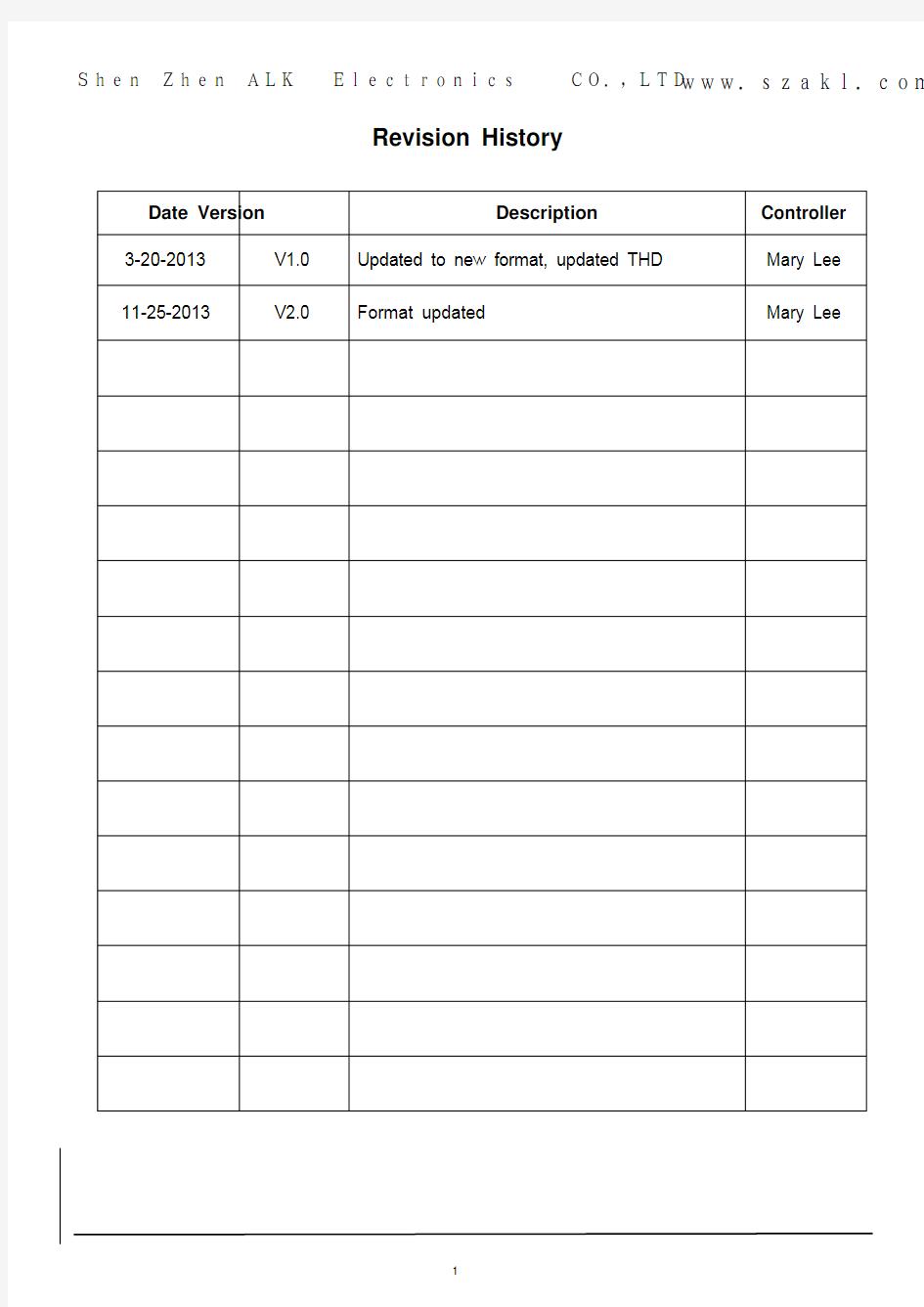ALK-BFA423-01硅麦克风


Document No. ME-01-02-005
RoHS Compliance & Halogen Free
Product : 3.76x2.95x1.1mm Analog Top Port + MAXRF GETTOP P/N :
Version : V2.0
Designed by
Checked by
Confirmed by
Approved by Released Date
Shen Zhen ALK Electronics CO.,LTDwww.szakl.com
ALK-BFA423-01
Revision History
Date Version Description Controller 3-20-2013 V1.0 Updated to new format, updated THD Mary Lee 11-25-2013 V2.0 Format updated Mary Lee
Contents
1. Scope (3)
2. Product Type (3)
3. Electro-Acoustic Specifications (3)
4. Frequency Response (4)
5. Measurement System Setup (5)
6. Dimension (6)
7. Reliability Tests (6)
7.1 Hi-Temperature Test (6)
7.2 Low-Temperature Test (6)
7.3 Humidity & Heat Test (6)
7.4 Thermal Shocking Test (7)
7.5 Vibration Test (7)
7.6 Drop Test (7)
7.7 Electrostatic Discharge (7)
8. Packaging (8)
9. Application Design Suggestions (9)
9.1 Recommended PCB Design (9)
9.2 Temperature Profile during Reflow Process (9)
9.3 Recommended Pick-up Area (10)
10. Special Cautions (10)
10.1 Air Rifle Cleaning Restriction (11)
10.2 Board Wash Restriction (11)
10.3 Vacuum Restriction (11)
10.4 Environmental Condition (11)
10.5 Storage (11)
11. References (11)
1. Scope
This document is the technical specification of a MEMS microphone.
2. Product Type
Product Number:
Product Description:
3.76x2.95x1.1mm Analog Top Port. With MAXRF protection.
3. Electro-Acoustic Specifications
Test condition: +20℃, 45%~75% RH, 86~106Kpa, Vdd=2V, unless specified differently.
Table 3-1 Electrical Specifications
No. Parameter Symbol Condition Limits
Unit
Min Nom. Max
3.1 Sensitivity S
f=1kHz, Pin=1Pa,
0dB=1V/Pa -45 -42 -39 dB 3.2 Directivity
Omni-directional
3.3 Output
Impedance ZOUT f =
1kHz 200 ? 3.4
Current Consumption
IDSS
1.5V to 3.3V
90
250
μA
3.5 S/N Ratio S/N
f=1kHz, Pin=1Pa,
(A-Weighted) 59 dB 3.6 Operating Voltage
1.5
2 3.3
V 3.7 Sensitivity vs.
Voltage ΔS Vs= 3.3V to 1.5V <0.5 dB 3.8 Total Harmonic Distortion
THD
100dB SPL @1KHz 1 %
115dB SPL @1KHz
5
ALK-BFA423-01
4. Frequency Response
10k
5k 3k 1k 500
200
100
Frequency (Hz)
R e l a t i v e R e s p o n s e (d B )
+10+5-50-10-20
-15+1550
+20
Fig. 4-1 Frequency Response
Table 4-1 Frequency Response Limit Template
Frequency
[Hz] 100 200 500 3K 5K 8K Upper Limit
[dB] 2 2 2 2 3 7 Lower Limit
[dB]
-2 -2 -2 -2 -2 -2
* Limits for intermediate frequencies are found by drawing straight lines between the breaking points in the table on a linear dB – logarithmic frequency scale.
5. Measurement System Setup
Test signal: Sinusoid, Sweep, Frequency Range: 50Hz-17KHz Step: 1/12 octave
Fig. 5-1 Measurement System Setup
DUT MIC
B&K 3560C
Transfer data through transmission line
Output Input
2716C-001 Audio amplifier
Turn-table controller
Anechoic
chamber
B&K4191 L001
Free field 1/2 inch MIC Tannoy Speaker
Free field 50cm
6. Dimension
TOP VIEW
BOTTOM VIEW
Unmarked Tolerance: ± 0.1 (mm)
Pad definition: 1--OUTPUT 2-- GND 3--GND 4-- V DD
Fig. 6-1 Dimension
7. Reliability Tests
All the test conditions of the Reliability Tests are specified in the reference document, listed in Section 12.
After conducting any of the following tests, the sensitivity change of DUT shall be less than ±3dB from its initial value and shall keep its initial operation and appearance.
7.1 Hi-Temperature Test
Temperature: +85℃
Duration: 240 hours
7.2 Low-Temperature Test
Temperature: -40℃
Duration: 240 hours
7.3 Humidity & Heat Test
Temperature: +70℃
Humidity: 93% RH
Duration: 240 hours
7.4 Thermal Shocking Test
Temperature & Duration: -40℃, 30 minutes
Temperature & Duration: +80℃, 30 minutes,
Cycles: 32 cycles
7.5 Vibration Test
Frequency: 10-55Hz
Amplitude: 1.52mm
Direction: 2 directions
Duration: 2 hours
7.6 Drop Test
Drop the microphones to the floor without package.
Height: 1.5m
Reference Surface: slippery marble floor
Duration: 5 times
7.7 Electrostatic Discharge
The tests are performed acc. to IEC61000-4-2 level 3:
a. Contact Discharge
Discharge Position: Output of Microphone
Charge Voltage: ±6000VDC
Discharge Network: 150pF & 330?
b. Air Discharge
Discharge Position: Sound Hole
Charge Voltage: ±8000VDC
Discharge Network: 150pF & 330?
8. Packaging
* Use ESD reel and tape for microphone packaging.
* Anti-static measures should be applied during packaging operation.
Tape and Reel φ330mm 5,500PCS×1=
5,500PCS
Batch Box 120mm*350mm*365mm
5,500PCS×5=27,500PCS
Shipping Box
265mm*375mm*400mm 27,500PCS×2=
55,000PCS
Fig. 8-1 Packaging
Shen Zhen ALK Electronics CO.,LTDwww.szakl.com
9. Application Design Suggestions
9.1 Recommended PCB Design:
Fig. 9-1 Recommended PCB Design
9.2 Temperature Profile during Reflow Process:
Table 9-1 Temperature Profile during Reflow Process
Parameter Reference Specification Average Temperature Gradient in Preheating 2.5°C/s
Soak Time Tsoak 2-3 minutes Time above 217°C t1 Max 60s
Time above 230°C t2 Max 50s
Time above 250°C t3 Max 10s
Peak Temperature in Reflow Tpeak 255°C (–0/+5°C) Temperature Gradient in Cooling Max -5°C/s
9.3 Recommended Pick-up Area:
Fig. 9-3 Recommended Pick-up Area
T peak
T T T
Fig. 9-2 Reflow Profile
*After the initial reflow, the MIC shall be resumed to room temperature if more reflow is needed.
*The test should be conducted after the MIC unit has been exposed to room temperature for 3 hours.
10. Special Cautions
10.1 Air Rifle Cleaning Restriction
Do not bring air rifle to the port hole directly.
Recommended Condition:
Air pressure < 0.3MPa;
Distance > 5cm;
Time < 5 sec.
10.2 Board Wash Restriction
It is prohibited to wash the board after reflow process. This could damage the MIC.
10.3 Vacuum Restriction
It is prohibited to use a vacuum over the port hole of the MIC. This could damage the MIC.
10.4 Environmental Condition
Storage Condition:-40℃~+100℃, R.H. < 90%
Operation Condition:-40℃~+100℃, R.H. < 90%
Arbitration Condition: 20℃±1℃,R.H. 63%~67%, Air pressure: 86~106KPa
10.5 Storage
The component needs to meet the requirement of MSL(Moisture Sensitivity Level) class 2a. Please keep MICs in warehouse with humidity less than 75% and without sudden temperature change, acid air, and any other harmful air or strong magnetic field.
Please protect products against moist, shock, sunburn and pressure.
Please take proper measures against ESD in the process of assembly and transportation..
Please use the shipping package for long-term storage.
11. References
1) “Reliability Test Manual at Shandong Gettop Acoustic Co. Ltd.”, SM-III-S080-04-E.
